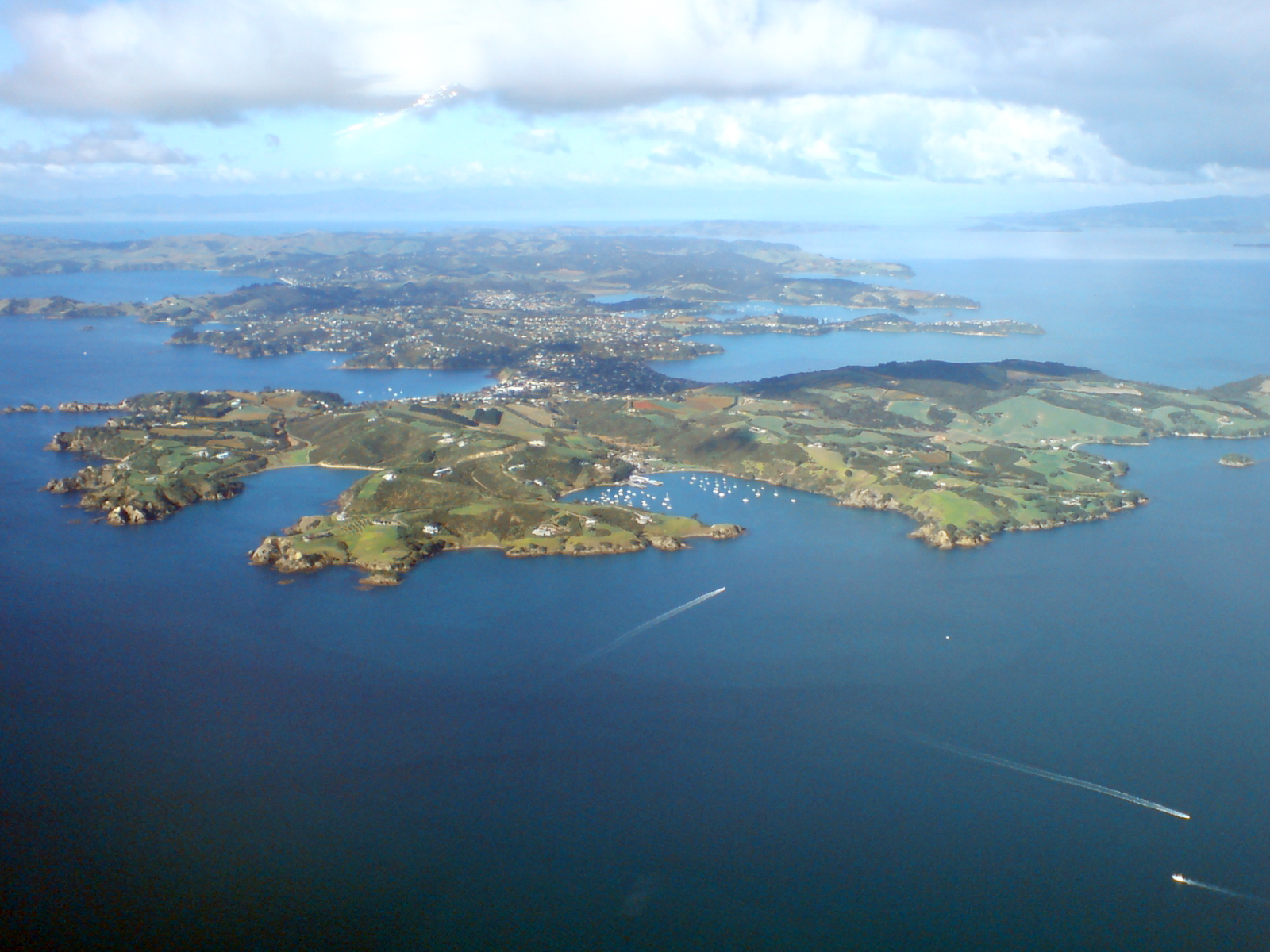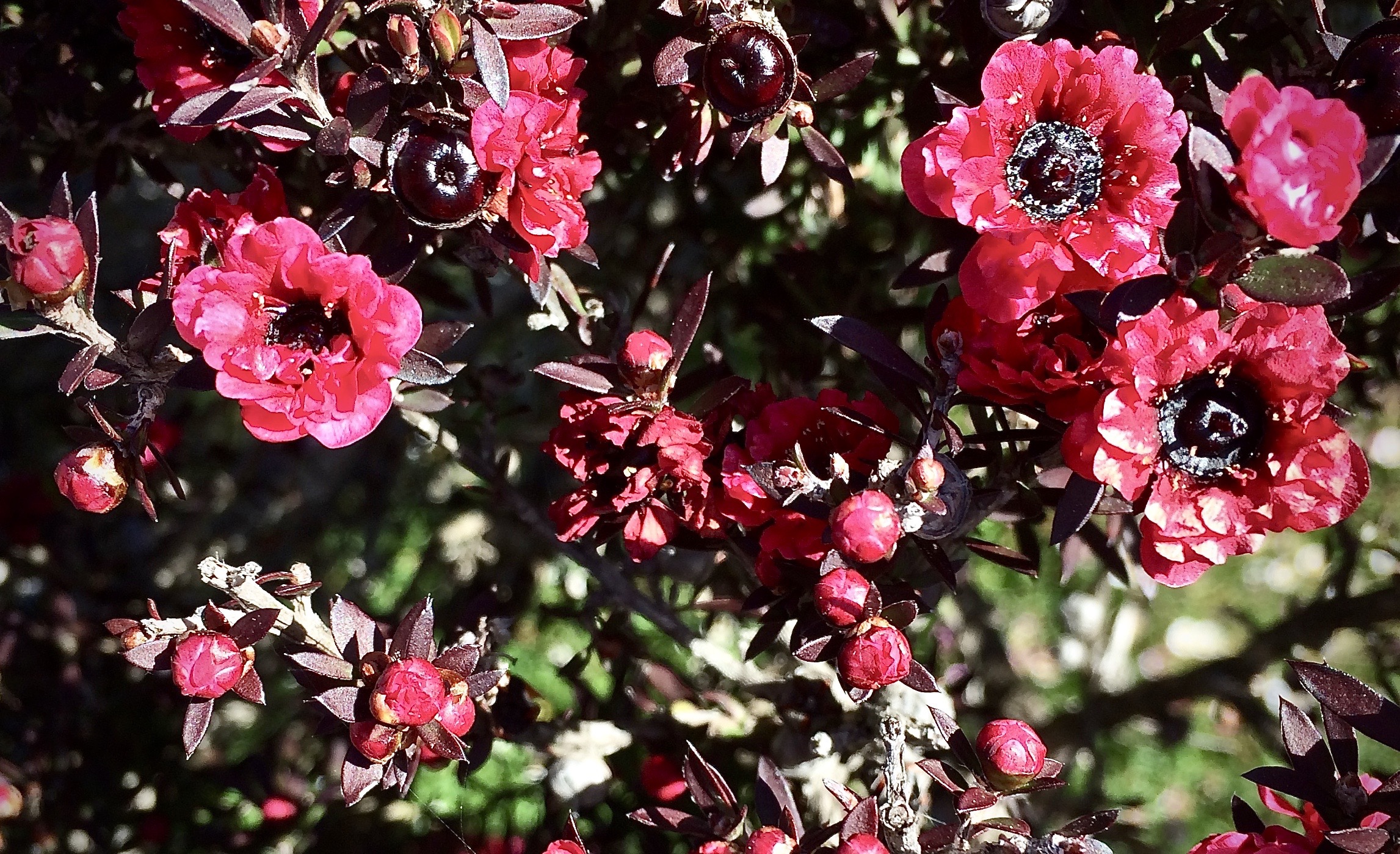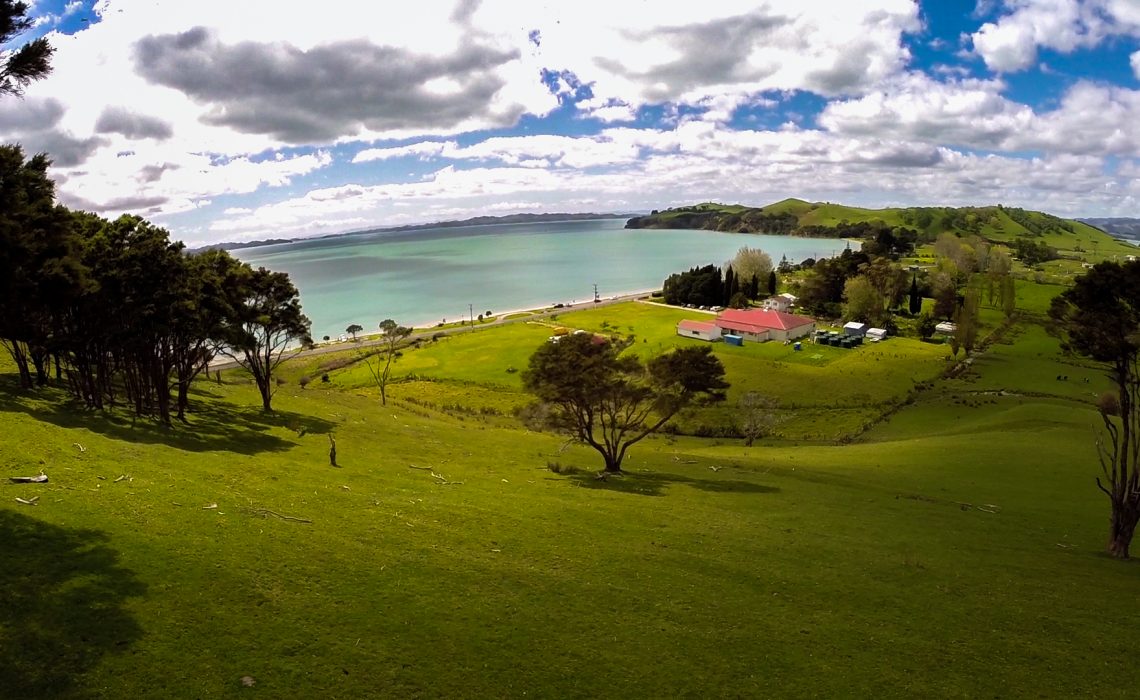|
Whakanewha Regional Park
Whakanewha Regional Park is a regional park situated on Waiheke Island in New Zealand's Hauraki Gulf. It is owned and operated by Auckland Council. Geography Whakanewha is located in central Waiheke Island, on the southern coast. The regional park extends from the ridge line towards Rocky Bay / Whakanewha Bay, and includes the catchments of three streams which flow into the bay. The forest is dominated by broadleaf trees including Beilschmiedia tarairi, taraire and pūriri, and podocarp trees such as kahikatea and tānekaha. A large wetland is found in the south-west of the park, which is a habitat for species including the New Zealand bittern, Buff-banded rail, banded rail and New Zealand fernbird, fernbird. History Whakanewha has a long history of Tāmaki Māori occupation. Large shell middens are located here, as well as a pā site. The name translates to "shading eyes from the setting sun". Groups with association to the area include Ngāti Pāoa, Ngāi Tai ki Tāmaki and T ... [...More Info...] [...Related Items...] OR: [Wikipedia] [Google] [Baidu] |
Waiheke Island
Waiheke Island (; Māori: ) is the second-largest island (after Great Barrier Island) in the Hauraki Gulf of New Zealand. Its ferry terminal in Matiatia Bay at the western end is from the central-city terminal in Auckland. It is the most populated island in the gulf, with permanent residents. Another estimated 3,400 have second homes or holiday homes on the island. It is New Zealand's most densely populated island, and the third most populated after the North and South Islands. It is the most accessible island in the gulf, with regular passenger and car-ferry services, a helicopter operator based on the island, and other air links. In November 2015, Lonely Planet rated Waiheke Island the fifth-best region in the world to visit in 2016. Geography Overview The island is off the coast of the North Island. It is in length from west to east, varies in width from , and has a surface area of . The coastline is , including of beaches. The port of Matiatia at the western end is ... [...More Info...] [...Related Items...] OR: [Wikipedia] [Google] [Baidu] |
Tāmaki Māori
Tāmaki Māori are Māori ''iwi'' and ''hapū'' (tribes and sub-tribes) who have a strong connection to Tāmaki Makaurau (the Auckland Region), and whose rohe was traditionally within the region. Among Ngā Mana Whenua o Tāmaki Makaurau (the Māori tribes of Auckland), also known as the Tāmaki Collective, there are thirteen iwi and hapū, organised into three rōpū (collectives), however Tāmaki Māori can also refer to subtribes and historical iwi not included in this list. Ngāti Whātua Rōpū Ngāti Whātua descend from the '' Māhuhu-ki-te-rangi'' waka, which landed north of the Kaipara Harbour. The rōpū includes Ngāti Whātua o Kaipara, Ngāti Whātua Ōrākei and Te Rūnanga o Ngāti Whātua. Te Rūnanga o Ngāti Whātua is a Māori Trust Board formed in the mid 2000s to represent the interests of Ngāti Whātua iwi and hapū collectively, including those outside of Ngāti Whātua o Kaipara and Ngāti Whātua Ōrākei. The rūnanga represents Ngā Oho, Ngāi Tāh ... [...More Info...] [...Related Items...] OR: [Wikipedia] [Google] [Baidu] |
Giant Kōkopu
The giant kōkopu (''Galaxias argenteus'') is a threatened species of ray-finned fish in the genus ''Galaxias'', found only in New Zealand. It can reach up to in length and in weight, making it the largest species in the family Galaxiidae. It is a mainly lowland species, commonly found in slow-flowing streams, wetlands, lakes, and lagoons. Most populations have an amphidromous life cycle, with larvae going to sea soon after hatching and returning about four months later as small juveniles, . Juvenile giant kōkopu form a small part of the annual whitebait catch. Etymology The first species in the family Galaxiidae to be described by scientists, the giant kōkopu was initially placed in the genus ''Esox'' (pikes) by Johann Friedrich Gmelin in 1789. Cuvier recognised that it was not a pike and in 1816 coined the genus name ''Galaxias'' as a reference to its star-like (galaxy) markings. The genus was later expanded to include numerous other species, most of which lack this patter ... [...More Info...] [...Related Items...] OR: [Wikipedia] [Google] [Baidu] |
Kunzea Ericoides
''Kunzea ericoides'', commonly known as kānuka, kanuka, white tea-tree or burgan, is a tree or shrub in the myrtle family, Myrtaceae and is endemic to New Zealand. It has white or pink flowers similar to those of ''Leptospermum'' and from its first formal description in 1832 until 1983 was known as ''Leptospermum ericoides''. The flowers have five petals and up to 25 stamens which are mostly longer than the petals. Description ''Kunzea ericoides'' is a spreading shrub or tree, sometimes growing to a height of with bark which peels in long strips and young branches which tend to droop. The leaves are variable in shape from linear to narrow elliptic or lance-shaped, long and wide with a petiole up to long. The flowers are white or pale pink, crowded on side branches or in the axils of upper leaves. The floral cup is covered with soft, downy hairs and is on a pedicel long. There are five triangular sepals about long and five petals about long. There are up to 25 stamens w ... [...More Info...] [...Related Items...] OR: [Wikipedia] [Google] [Baidu] |
Leptospermum Scoparium
''Leptospermum scoparium'', commonly called mānuka, () mānuka myrtle, New Zealand teatree, broom tea-tree, or just tea tree, is a species of flowering plant in the myrtle family Myrtaceae, native to New Zealand (including the Chatham Islands) and south-east Australia. Its nectar produces Mānuka honey. Description Mānuka is a prolific shrub-type tree and is often one of the first species to regenerate on cleared land. It is typically a shrub growing to tall, but can grow into a moderately sized tree, up to or so in height. It is evergreen, with dense branching and small leaves long and broad, with a short spine tip. The flowers are white, occasionally pink, – rarely up to – in diameter, with five petals. The wood is tough and hard. Mānuka is often confused with the related species kānuka (''Kunzea ericoides'') – the easiest way to tell the difference between the two species in the field is to feel their foliage – mānuka leaves are prickly, while kānuka lea ... [...More Info...] [...Related Items...] OR: [Wikipedia] [Google] [Baidu] |
New Zealand Government
, background_color = #012169 , image = New Zealand Government wordmark.svg , image_size=250px , date_established = , country = New Zealand , leader_title = Prime Minister Jacinda Ardern , appointed = Governor-General , main_organ = , ministries = 32 ministries and departments , responsible = House of Representatives , budget = 119.3 billion (2018–19) , address = The Beehive and other locations across Wellington , url = The New Zealand Government ( mi, Te Kāwanatanga o Aotearoa) is the central government through which political authority is exercised in New Zealand. As in most other parliamentary democracies, the term "Government" refers chiefly to the executive branch, and more specifically to the collective ministry directing the executive. Based on the principle of responsible government, it operates within the framework that "the Queen reigns, but the government rules, so long as it has the support of the House of Representatives".Sir Kenneth Keith, qu ... [...More Info...] [...Related Items...] OR: [Wikipedia] [Google] [Baidu] |
Auckland
Auckland (pronounced ) ( mi, Tāmaki Makaurau) is a large metropolitan city in the North Island of New Zealand. The List of New Zealand urban areas by population, most populous urban area in the country and the List of cities in Oceania by population, fifth largest city in Oceania, Auckland has an urban population of about It is located in the greater Auckland Region—the area governed by Auckland Council—which includes outlying rural areas and the islands of the Hauraki Gulf, and which has a total population of . While European New Zealanders, Europeans continue to make up the plurality of Auckland's population, the city became multicultural and Cosmopolitanism, cosmopolitan in the late-20th century, with Asian New Zealanders, Asians accounting for 31% of the city's population in 2018. Auckland has the fourth largest Foreign born, foreign-born population in the world, with 39% of its residents born overseas. With its large population of Pasifika New Zealanders, the city is ... [...More Info...] [...Related Items...] OR: [Wikipedia] [Google] [Baidu] |
Te Ākitai Waiohua
Te Ākitai Waiohua is a Māori iwi of the southern part of the Auckland Region of New Zealand. History Te Ākitai Waiohua are descended from Kiwi Tāmaki, the grandson of Huakaiwaka, himself the ancestor of the Waiohua iwi, who lived in Tāmaki (the Auckland isthmus). The name ''Te Ākitai'' commemorates Kiwi Tāmaki's uncle Huatau, who, in the early 18th century, died at sea in the Manukau Harbour and whose body was dashed up (''āki'') by the sea (''tai'') on Puketutu Island. Kiwi Tāmaki was killed in battle with Te Taoū ''hapū'' (sub-tribe) of Ngāti Whātua in the mid-18th century. Ngāti Whātua settled in Tāmaki and the Waiohua retreated to Drury, Pōkeno, Kirikiri/Papakura, Ramarama and other parts of South Auckland. In the 1780s Te Ākitai Waiohua re-established settlements at Wiri, Pūkaki and Otahuhu. Kiwi Tāmaki had a surviving son named Rangimatoru, who lived in South Auckland with Ngā Oho, a hapū of Ngāti Whātua Ōrākei formed by intermarriages between ... [...More Info...] [...Related Items...] OR: [Wikipedia] [Google] [Baidu] |
Ngāi Tai Ki Tāmaki
Ngāi Tai ki Tāmaki is a Māori tribe that is based in the area around Clevedon, part of the Auckland region (''Tāmaki'' in the Māori language). It is one of the twelve members of the Hauraki Collective of tribes. The founding ancestors of Ngāi Tai ki Tāmaki came to New Zealand in the ''Tainui'' migration canoe and left it when it was dragged across Te Tō Waka, the portage from the Tāmaki River to the Manukau Harbour. Their descendants occupied parts of the Hauraki Gulf, including east Auckland as far inland as Otara and Maungarei, as well as Clevedon, Maraetai and Howick. Te Irirangi Drive, a major highway in Manukau City, is named after one of their ''rangatira'' (chiefs), Tara Te Irirangi. Ngāi Tai has a marae at Umupuia Beach, between Maraetai and Clevedon. They also use the Ngāti Tamaoho marae at Karaka. In 2015 the Crown settled with Ngāi Tai ki Tāmaki over historic grievances, including both financial and cultural compensation. See also *List of iwi ... [...More Info...] [...Related Items...] OR: [Wikipedia] [Google] [Baidu] |
Ngāti Pāoa
Ngāti Pāoa is a Māori people, Māori ''iwi'' (tribe) that has extensive links to the Hauraki and Waikato tribes of New Zealand. Its traditional lands stretch from the western side of the Hauraki Plains to Auckland. They also settled on Hauraki Gulf islands such as Waiheke Island, Waiheke. Ngāti Pāoa is one of five tribes of the Marutūāhu confederation, the others being Ngāti Maru (Hauraki), Ngāti Maru, Ngāti Rongoū, Ngāti Tamaterā and Ngāti Whanaunga. The Marutūāhu tribes are all descended from Marutūāhu, a son of Hotunui, who is said to have arrived in New Zealand on the ''Tainui (canoe), Tainui'' canoe. The Marutūāhu tribes are therefore part of the Tainui group of tribes. The Marutūāhu confederation is also part of the Hauraki Māori, Hauraki collective of tribes. History Early history Ngāti Pāoa are descended from Paoa. His story is woven into the history of Tainui waka, and of the Waikato and Hauraki tribes with enduring links to the Te Arawa tribe ... [...More Info...] [...Related Items...] OR: [Wikipedia] [Google] [Baidu] |
Shell Midden
A midden (also kitchen midden or shell heap) is an old dump for domestic waste which may consist of animal bone, human excrement, botanical material, mollusc shells, potsherds, lithics (especially debitage), and other artifacts and ecofacts associated with past human occupation. These features provide a useful resource for archaeologists who wish to study the diets and habits of past societies. Middens with damp, anaerobic conditions can even preserve organic remains in deposits as the debris of daily life are tossed on the pile. Each individual toss will contribute a different mix of materials depending upon the activity associated with that particular toss. During the course of deposition sedimentary material is deposited as well. Different mechanisms, from wind and water to animal digs, create a matrix which can also be analysed to provide seasonal and climatic information. In some middens individual dumps of material can be discerned and analysed. Shells A shell mid ... [...More Info...] [...Related Items...] OR: [Wikipedia] [Google] [Baidu] |
New Zealand Fernbird
The New Zealand fernbird or simply fernbird (''Poodytes punctatus'') is an insectivorous bird endemic to New Zealand. In the Māori language, it is named or . Taxonomy The New Zealand fernbird was described by the French zoologists Jean Quoy and Joseph Gaimard in 1832 from a specimen collected in Tasman Bay / Te Tai-o-Aorere, South Island, New Zealand. They coined the binomial name, ''Synallaxis punctata''. In the past, this species had the binomial name ''Megalurus punctatus.'' There are five subspecies present on different islands. They differ in extent of reddish-brown and intensity of streaking, as well as size: * ''P. p. vealeae'' (Kemp, R, 1912) – North Island (New Zealand) * ''P. p. punctatus'' (Quoy & Gaimard, 1832) – South Island (New Zealand) * ''P. p. stewartianus'' ( Oliver, 1930) – Stewart Island (New Zealand) * ''P. p. wilsoni'' ( Stead, 1936) – Codfish Island (=Whenua Hou, west of Stewart Island, New Zealand) * ''P. p. caudatus'' ( Buller, 1894) – ... [...More Info...] [...Related Items...] OR: [Wikipedia] [Google] [Baidu] |



_p225_AUCKLAND%2C_NEW_ZEALAND.jpg)


_(cropped).jpg)